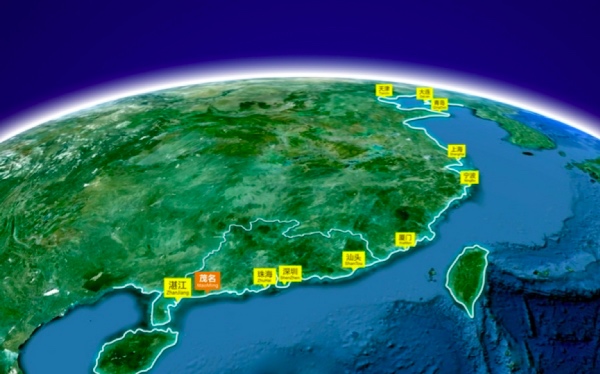Maoming Port
- Updated: 2024-03-18
Maoming Port lies at the southern coastline of China in west Guangdong province. It is not only the center of the water and land traffic of Guangzhou and Zhanjiang, but also the hub of west Guangdong. In the neighborhood, there are the Pearl River Delta (east), Beibu Gulf (west), the South China Sea (south), and the vast Southeast China and the Central China region (north). As stated in the International Development of China by Sun Yat-sen, a leader of the Chinese Nationalist Party, known as the father of modern China, in 1919, it was defined as one of the nine commercial harbors and described as a port “able to accommodate giant vessels”.

Maoming port [Photo provided to guangdong.chinadaily.com.cn/maoming]
It’s a unique fine deep harbor, with natural depth of water reaching 15 m, the coastline up to 220 km, and the port’s coast 60.2 km long. On land, it is 380 km away from Guangzhou and 100 km away from Zhanjiang, and thus recognized as the center of the water and land traffic of Guangzhou and Zhanjiang. It is 178 sea miles away from Hong Kong in the east, 246 sea miles away from Guangzhou Port in the north, 68 sea miles away from Zhanjiang Port in the west, and 134 sea miles away from Haikou.
Maoming Port can be reached from all directions; Luoyang-Zhanjiang Railway, Sanshui-Maoming Railway, Hechun-Maoming Railway and Maoming-Zhanjiang Railway meet here, which enables Maoming Port to be connected with South China, Southwest China, and South Central China. It is also accessible by Shenhai Expressway, No 325 National Highway, and No 207 National Highway.
Along with the construction of high-speed railways in coastal areas in west Guangdong, including Baotou-Maoming Railway, Maoming Port will be the most convenient and the most economic channel.
As a national class A port opening to the outside world, Maoming Port is also an important regional harbor, an important hub for regional comprehensive transport system, and a major import oil and gas reception, unloading, transit and storage system in the port groups, a large coastal owner’s wharf in China, and one of the four largest import oil reception and unloading ports in China.
There are three harbors at present, namely, Bohe, Shuidong and Jida, with the annual throughput in 2011 up to 23.06 million tons; as planned, there would be 75 over 10,000 tonnage berths, with the planned throughput capacity of 60 million tons, but 0.2 billion tons for long-term development plan.


